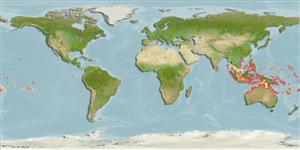>
Ovalentaria/misc (Various families in series Ovalentaria) >
Pomacentridae (Damselfishes) > Pomacentrinae
Etymology: Chrysiptera: Greek, chrysos = golden + Greek, pteron = fin, wing (Ref. 45335); rollandi: Named for Mr. Jean Rolland (R.Bajol, pers.comm. 06/16).
Eponymy: Jean Rolland (1933–2018) was a highly skilled welder by trade. [...] (Ref. 128868), visit book page.
More on author: Whitley.
Environment: milieu / climate zone / distribuzione batimetrica / distribution range
Ecologia
marino associati a barriera corallina; non migratori; distribuzione batimetrica 2 - 35 m (Ref. 7247). Tropical; 20°N - 23°S
Eastern Indian Ocean and Western Pacific: Andaman Sea to the Loyalty Islands, north to the Philippines, south to the Great Barrier Reef and New Caledonia. Recently recorded from Tonga (Ref. 53797).
Size / Peso / Age
Maturità: Lm ? range ? - ? cm
Max length : 7.5 cm TL maschio/sesso non determinato; (Ref. 48636)
Short description
Chiavi di identificazione | Morfologia | Morfometria
Spine dorsali (totale) : 13; Raggi dorsali molli (totale) : 10 - 11; Spine anali: 2; Raggi anali molli: 12 - 13.
Body shape (shape guide): fusiform / normal; Cross section: compressed.
Adults occur singly or in small groups in lagoons, harbors, and outer reef slopes. Found among corals and coral rubble (Ref. 9710). Feed mainly on zooplankton. Oviparous, distinct pairing during breeding (Ref. 205). Eggs are demersal and adhere to the substrate (Ref. 205). Males guard and aerate the eggs (Ref. 205). DNA analysis suggests that this species could be divided to three species at least, i.e. fish from (1) Andaman Sea, (2) Indo-Australian archipelago, and (3) New Caledonia and southern Coral Sea are distinct species. Diurnal species (Ref. 54980; 113699).
Life cycle and mating behavior
Maturità | Riproduzione | Deposizione | Uova | Fecundity | Larve
Oviparous, distinct pairing during breeding (Ref. 205). Eggs are demersal and adhere to the substrate (Ref. 205). Males guard and aerate the eggs (Ref. 205).
Allen, G.R., 1991. Damselfishes of the world. Mergus Publishers, Melle, Germany. 271 p. (Ref. 7247)
IUCN Red List Status (Ref. 130435: Version 2025-1)
Threat to humans
Harmless
Human uses
Pesca: di nessun interesse; Acquario: Commerciale
Strumenti
Special reports
Download XML
Fonti Internet
Estimates based on models
Preferred temperature (Fonte Biblio.
123201): 25.7 - 29.3, mean 28.6 °C (based on 2147 cells).
Phylogenetic diversity index (Fonte Biblio.
82804): PD
50 = 0.5000 [Uniqueness, from 0.5 = low to 2.0 = high].
Bayesian length-weight: a=0.01479 (0.00651 - 0.03363), b=3.00 (2.81 - 3.19), in cm total length, based on LWR estimates for this (Sub)family-body shape (Ref.
93245).
Trophic level (Fonte Biblio.
69278): 2.7 ±0.30 se; based on food items.
Resilienza (Fonte Biblio.
120179): Alto, tempo minimo di raddoppiamento della popolazione meno di 15 mesi (Preliminary K or Fecundity.).
Fishing Vulnerability (Ref.
59153): Low vulnerability (10 of 100).
🛈
Nutrients (Ref.
124155): Calcium = 150 [84, 257] mg/100g; Iron = 0.95 [0.59, 1.49] mg/100g; Protein = 18.5 [17.5, 19.5] %; Omega3 = 0.162 [0.099, 0.256] g/100g; Selenium = 23.6 [13.4, 42.8] μg/100g; VitaminA = 138 [48, 403] μg/100g; Zinc = 2.37 [1.64, 3.27] mg/100g (wet weight);
